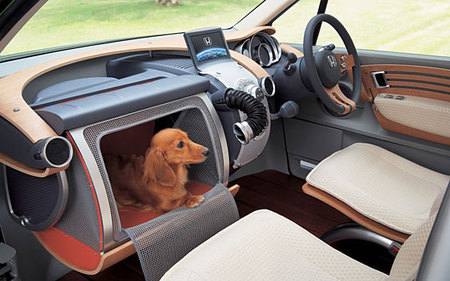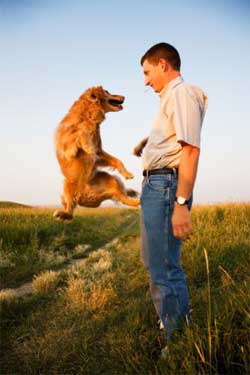Puppy Biting is Normal, Natural, and Necessary!
Puppy biting seldom causes appreciable harm, but many bites are quite painful and elicit an appropriate reaction—a yelp and a pause in an otherwise extremely enjoyable play session. Thus, your puppy learns that his sharp teeth and weak jaws can hurt. Since your puppy enjoys play-fighting, he will begin to inhibit the force of his biting to keep the game going. Thus your puppy will learn to play-bite gently before he acquires the formidable teeth and strong jaws of an adolescent dog.
Forbidding a young puppy from biting altogether may offer immediate and temporary relief, but it is potentially dangerous because your puppy will not learn that his jaws can inflict pain. Consequently, if ever provoked or frightened as an adult, the resultant bite is likely to be painful and cause serious injury.
Certainly, puppy play-biting must be controlled, but only in a progressive and systematic manner. The puppy must be taught to inhibit the force of his bites, before puppy biting is forbidden altogether. Once your puppy has developed a soft mouth, there is plenty of time to inhibit the frequency of his now gentler mouthing.
Teaching your puppy to inhibit the force of his bites is a two-step process: first, teach the pup not to hurt you; and second, teach your pup not to exert any pressure at all when biting. Thus the puppy's biting will become gentle mouthing.
Puppy biting seldom causes appreciable harm, but many bites are quite painful and elicit an appropriate reaction—a yelp and a pause in an otherwise extremely enjoyable play session. Thus, your puppy learns that his sharp teeth and weak jaws can hurt. Since your puppy enjoys play-fighting, he will begin to inhibit the force of his biting to keep the game going. Thus your puppy will learn to play-bite gently before he acquires the formidable teeth and strong jaws of an adolescent dog.
Forbidding a young puppy from biting altogether may offer immediate and temporary relief, but it is potentially dangerous because your puppy will not learn that his jaws can inflict pain. Consequently, if ever provoked or frightened as an adult, the resultant bite is likely to be painful and cause serious injury.
Certainly, puppy play-biting must be controlled, but only in a progressive and systematic manner. The puppy must be taught to inhibit the force of his bites, before puppy biting is forbidden altogether. Once your puppy has developed a soft mouth, there is plenty of time to inhibit the frequency of his now gentler mouthing.
Teaching your puppy to inhibit the force of his bites is a two-step process: first, teach the pup not to hurt you; and second, teach your pup not to exert any pressure at all when biting. Thus the puppy's biting will become gentle mouthing.
Puppies bite. And thank goodness they do! Puppy play-fighting and play-biting are essential for
your puppy to develop a soft mouth as an adult.
Teaching your puppy to inhibit the frequency of his mouthing is a two-step process: first,
teach your puppy that whereas mouthing is OK, he must stop when requested; and second,
teach your pup never to initiate mouthing unless requested.
No Pain
It is not necessary to hurt or frighten your pup to teach her that biting hurts. A simple "Ouch!" is sufficient. If your pup acknowledges your "ouch" and stops biting, praise her, lure her to sit (to reaffirm that you are in control), reward her with a liver treat, and then resume playing. If your pup ignores the "ouch" and continues biting, yelp "Owwwww!" and leave the room. Your puppy has lost her playmate. Return after a 30-second time-out and make up by lure-rewarding your puppy to come, sit, lie down, and calm down, before resuming play.
It is not necessary to hurt or frighten your pup to teach her that biting hurts. A simple "Ouch!" is sufficient. If your pup acknowledges your "ouch" and stops biting, praise her, lure her to sit (to reaffirm that you are in control), reward her with a liver treat, and then resume playing. If your pup ignores the "ouch" and continues biting, yelp "Owwwww!" and leave the room. Your puppy has lost her playmate. Return after a 30-second time-out and make up by lure-rewarding your puppy to come, sit, lie down, and calm down, before resuming play.
Do not attempt to take hold of your pup’s collar, or
carry her to confinement; you are out of control and she
will probably bite you again. Consequently, play with
your puppy in a room where it is safe to leave her if she
does not respond to your yelp. If she ignores you, she
loses her playmate.
No Pressure
Once your pup's biting no longer hurts, still pretend that it does. Greet harder nips with a yelp of pseudo-pain. Your puppy will soon get the idea: "Whooahh! These humans are soooo super- sensitive. I'll have to be much gentler when I bite them." The pressure of your puppy's bites will progressively decrease until play-biting becomes play-mouthing.
Once your pup's biting no longer hurts, still pretend that it does. Greet harder nips with a yelp of pseudo-pain. Your puppy will soon get the idea: "Whooahh! These humans are soooo super- sensitive. I'll have to be much gentler when I bite them." The pressure of your puppy's bites will progressively decrease until play-biting becomes play-mouthing.
Never allow your puppy to mouth human hair or clothing. Hair and clothing cannot feel.
Allowing a puppy to mouth hair, scarves, shoelaces, trouser legs, or gloved hands,
inadvertently trains the puppy to bite harder, extremely close to human flesh!
Should a dog ever bite as an adult, both the prognosis for rehabilitation and the fate of the dog are almost always decided by the severity of the injury, which is predetermined by the level of bite inhibition the dog acquired during puppyhood. The most important survival lesson for a puppy is to learn bites cause pain! Your puppy can only learn this lesson if he is allowed to play-bite other puppies and people, and if he receives appropriate feedback.
For more detailed information about bite-inhibition exercises, read our Preventing Aggression booklet and watch the SIRIUS Puppy Training and Biting DVDs. Both are available on-line from www.amazon.com. If you feel you are having any difficulty whatsoever teaching your puppy to play-bite gently, seek help immediately. To locate a Certified Pet Dog Trainer (CPDT) in your area, contact the Association of Pet Dog Trainers at 1-800 PET DOGS or www.apdt.com.






















